Windbreak/Shelterbelt Design
Shelterbelt/Windbreak
Protecting your garden from the wind will increase productivity and decrease workload. Often overlooked, it should be one of the first things you consider when designing your garden or choosing a site. Wind can be a major suppressant of plant growth desiccating the soil and increasing the transpiration rates (water loss) of plants considerably. Strong winds can cause soil erosion, damage to plants and deter beneficial winged insects.
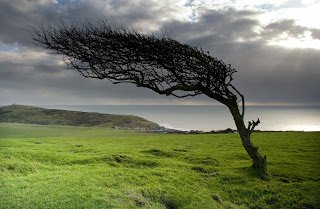
This tree signifies a prevailing wind coming from the right side of the picture. The growth directly exposed to the wind has been suppressed.
The advantages of a windbreak are many, however there are some disadvantages and if designed poorly one can create a bigger problem rather than finding a solution. So lets take a look at the potential problems first.
Frosts
Poorly designed windbreaks can encourage frosts and although generally are no problem during the winter as the plants have adapted protection, late spring frosts can be a problem for sensitive plants.
On a cold night the air nearest the ground is colder than that up above. The wind mixes it up preventing the lower layer from reaching freezing point. Sheltered areas are at more risk of frost than exposed areas. A windbreak that stops wind completely can increase the risk of frost and may even do more damage than good to the land it is protecting. By thinning out the shelter belt as it develops we can provide enough air flow to prevent this.
Root competition
The plants used within the shelter belt will obviously require their share of ground water and nutrients. The root system of certain trees can be prolific and extend way beyond the visible above ground spread. Care should be taken to avoid planting too close to the edge of the shelter belt especially if heavy demanding crops are the intended beneficiaries of the shelter belt. A good understanding of the root systems of the plants you are using can ensure that invasive and heavy feeding plants are kept away from the leeway edge. On larger sites the inside edge is sometimes used for road access thereby making use of the land that would otherwise give a poor return.
Pests and diseases
Consideration should be given to the ecology of the windbreak and how this may affect the surrounding areas. Certain trees will attract insects and wildlife not necessarily beneficial to other plants and trees. For example, Prunus cerasifera - Myrobalan Plum makes a great windbreak tree, growing fast, tolerating drought and wind. However fruit from these trees, if not collected, may provide breeding grounds for large populations of fruit boring organisms, such as Grapholita funebrana (Plum Moth), to establish. Once established these organisms may spread to all other Prunus spp. in the garden and surrounding areas.
Shading
Bear in mind the shadow the shelter belt will create when mature. The shadow cast, root competition and the space taken by the belt itself will use a considerable amount of viable land and this will need to be weighed up from the benefits gained from a shelter belt.
As mentioned above, if designed well, these potential problems can be avoided leaving you with all the advantages of a windbreak such as
Protection of plants
Preventing/reducing, wind erosion
Reducing evaporation from the soil
Reducing transpiration from plants
Protecting buildings (reducing fuel and maintenance needs)
Providing habitat and increasing biodiversity
Creating soil fertility
Productive potential, food, fodder, fuel, biomass, mulch, timber etc
Ornamental value
Moderating extreme temperatures
Design - Where to Start
Before establishing a windbreak or shelter belt it is important to make a thorough study of the local winds and to plot on a map the direction and strength of the winds.
Observing the wind
Wind can flow from any direction from horizontal to vertical depending on the energy balance. Wind can also curve or even rotate, a tornado for example. The units of measurement for wind speed is normally km/hr (kilometres per hour). Direction of wind is determined as a bearing angle from N. It is sufficient to use the eight points of the compass as a basis for determination of wind direction. Wind direction is noted from where it approaches, not where it is heading. There are many different types of instruments that measure wind speed and direction. However, the most common instrument used is known as an anemometer. It consists of three cups on arms that can rotate measuring wind speeds based on rate of rotations and a vane which indicates the wind direction.
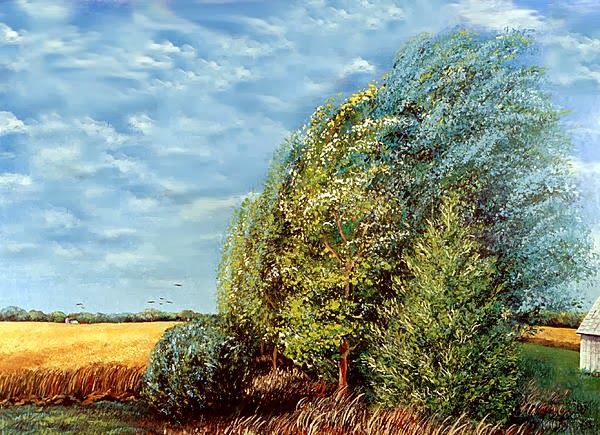
Basic forms of estimating wind strength and direction.
The movement of fast moving low clouds normally indicates the approximate direction of the wind. Fog also will move in the direction of the wind.
Wind can raise dust and other light objects and therefore following this movement is yet another technique that can help you estimate the strength and direction of the wind. It also can reveal eddies created by objects as wind flows around them. The same technique applies for blowing snow but this normally requires higher wind speeds.
If you are around a body of water, it is possible to observe surface flow of wind based on the changes in water texture or ripples. Relatively stronger winds will disturb the water surface causing ripples. This region of ripples or darker texture can be observed moving as the wind progresses.
Signs and patterns to help you determine the direction of prevailing winds
Often you will find higher vegetation such as trees and tall shrubs seemingly leaning in one direction as shown in the picture above. This neatly signals the occurrence of a prevailing wind. Weather vanes and Wind Socks are easily accessible tools for measuring wind direction
Wind in mountainous areas
Wind traveling across a mountainous region will move in waves. When clear of obstruction the wind can continue its wave motion creating eddies in the open plains.
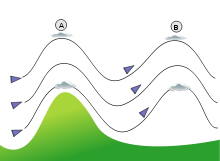
Motion of wind blowing across mountainous terrain
Design - Essential Points
Windbreaks can be effective on a small and large scale. They can be used for the temporary protection of annual crops and in this case can be as simple as a row of Helianthus tuberosum - Jerusalum artichoke planted to screen wind sensitive crop or they can be as complex as a multi-row perennial plantation of trees, shrubs ,herbs and ground covers to shield a broad acre plantation.
When considering windbreak or shelter belt planting, three zones can be recognized: the windward zone (from which the wind blows); the leeward zone (on the side where the wind passes); and the protected zone (that in which the effect of the windbreak or shelterbelt is felt)
A barrier should be established perpendicular to the direction of the prevailing wind for maximum effect. A checkerboard pattern is required when the winds originate from different directions. This applies mainly to broad acre sites.
The effectiveness of the windbreak or shelter belt is influenced by its permeability. If it is dense, like a solid wall, the airflow will pass over the top of it and cause turbulence on the leeward side giving a comparatively limited zone of effective shelter compared to the zone that a permeable shelter creates.
Optimum permeability is 40 to 50 percent of open space, corresponding to a density of 50 to 60 percent in vegetation.
It is generally accepted that a windbreak or shelter belt protects an area over a distance up to its own height on the windward side and up to 20 times its height on the leeward side, depending on the strength of the wind.
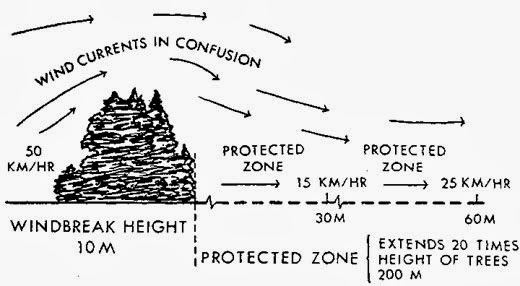
Gaps in the barriers should be avoided as they tend to channel accelerated wind through causing damage. If a gap is needed for access then further shelter should be provided to mitigate the wind passing through the gap.
Design - Selection of tree and shrub species
When selecting plant species for windbreaks or shelter belts, start by observing plants in your area that are in windy positions already. Look for healthiest specimens and if possible propagate from these specimens or obtain the same specie from a nearby nursery.
You may desire a larger diversity of plants within your design. When selecting plants the following characteristics should be sought:
Rapid growth
Straight stems
Wind firmness
Good crown formation
Deep root system, which does not spread into nearby fields
Resistance to drought
Desired phonological characteristics (leaves all year long or only part of the year).
Productivity: timber, fruits, nuts, medicine, biomass, fertility
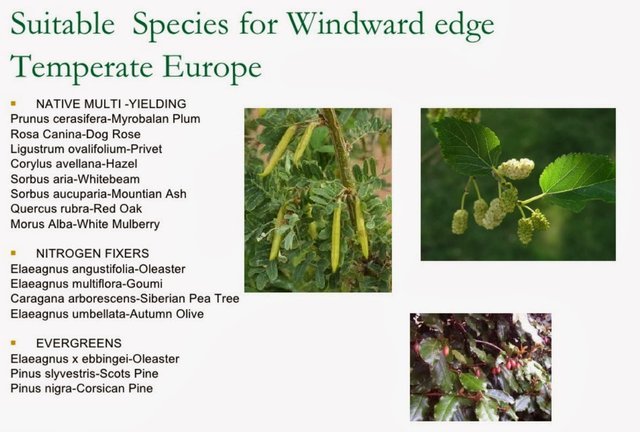
Design - Layout of Plants
There are a number of different ways to build a Shelter belt. It is generally accepted that multiple rows of plants provide increased protection. If using multiple rows, there is greater opportunity to obtain significant amount of food and resources from within the shelter belt as well as creating excellent habitat for a range of organisms many of which are beneficial allies to the gardener/farmer.
One method, pictured below, includes a windward row of small- med wind-firm trees with row of taller trees behind on the leeward row.
Windward Row
If the prevailing wind is blowing from the north then the windward row should be established first as the faster growing central trees will reduce light availability. The plants in this row need to be somewhat shade tolerant, fast growing and wind firm. Plants already growing in windy positions around your site should be first choice. A selection of nitrogen fixers, evergreens and wildlife plants should be selected. This layer needs to provide a lower screen for the higher canopied next layer so should consist of bushy trees and shrubs that fill out low to the ground.
Suitable Plants for Windward Row
Aronia melanocarpa - Black Chokeberry
Elaeagnus angustifolia - Russian Olive
Hippophae rhamnoides - Sea Buckthorn
Hibiscus syriacus - Rose of Sharon
Cornus mas - Cornellian Cherry
Lycium barbarum - Goji Berry
Rhus typhina - Stag's horn sumach
Alnus incana - Grey Alder
Elaeagnus umbellata - Autumn Olive
Leeward Row
The leeward row should consist of fast growing taller trees and include nitrogen fixers , conifer species and tree’s that sucker freely. This area can provide coppice wood for fence posts or fuel and consist of upper canopy fruit trees such as White Mulberry-Morus alba and Hackberry-Celtis occidentalis.
Suitable Plants for Leeward Row
Caragana brevispina - Pea Tree
Gleditsia triacanthos - Honey Locust
Celtis occidentalis - Hackberry
Prunus cerasifera - Cherry Plum
Alnus cordata - Italian Alder

Possible species selection for a three row Windbreak/Shelter belt
You can also find a good selection of suitable plants at the plants for a future database .
Would you like to join us for our Regenerative Landscape Design course in Sep 2017

Seeds for Forest Gardens and Permaculture

Balkan Ecology Project Bio-Nursery
Congratulations @balkep! You have completed some achievement on Steemit and have been rewarded with new badge(s) :
Click on any badge to view your own Board of Honnor on SteemitBoard.
For more information about SteemitBoard, click here
If you no longer want to receive notifications, reply to this comment with the word
STOPBy upvoting this notification, you can help all Steemit users. Learn how here!